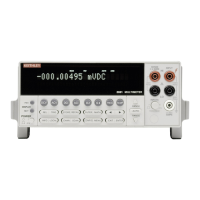IEEE-488 Reference
4-212
Description This action command is used to clear the buffer of readings. If you do not clear the buffer, a sub-
sequent store will overwrite the old readings. If the subsequent store is aborted before the buffer
becomes full, you could end up with some “old” readings still in the buffer.
Programming example OUTPUT 716; “:trac:cle” ! Clear buffer
4.23.2 :FREE? [BUFFER,]
:TRACe:FREE? [BUFFER,] Read status of memory
Format :trac:free?
Description This command is used to read the status of storage memory. After sending this command and
addressing the Model 2001 to talk, two values separated by commas will be sent to the computer.
The first value will indicate how many bytes of memory are available, and the second value will
indicate how many bytes are currently being used to store readings.
Programming example 10 OUTPUT 716; “:trac:free?”
20 ENTER 716; A$
30 PRINT A$
40 END
Line 10 Request status of memory.
Line 20 Addresses the Model 2001 to talk.
Line 30 Displays status of memory.
4.23.3 :EGRoup [BUFFER,] <name>
:TRACe:EGRoup [BUFFER,] <name> Specify element group
Parameters <name> = FULL Time stamp included with each stored reading
= COMPact Time stamp not included
Format :trac:egr <name>
Defaults Power-up FULL
*RST No effect
:SYSTem:PRESet No effect
Query :EGRoup? [BUFFER,] Query element group
Short-form format: :trac:egr?
Response message: FULL or COMP
Description This command is used to select the element group that is sent with each reading. Common to
both element groups are function, channel (if applicable) and buffer location. The FULL element
group includes the time stamp. The first reading in the buffer has a time stamp of 0 seconds. The
time stamp for all subsequent readings are then referenced to the first reading.
The COMpact element group excludes the time stamp. This allows the more readings to be
stored in the buffer (see :POINts).

